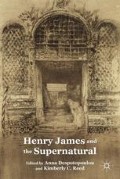Abstract
In the opening section of Volume II of Henry James’s novel The Ambassadors (1903), Lambert Strether, a middle-aged American in Paris, pays a visit to Notre Dame Cathedral. He has not come to worship, but simply to observe and to escape the subtleties of his social situation: “The great church had no altar for his worship, no direct voice for his soul; but it was none the less soothing even to sanctity; for he could feel while there what he couldn’t elsewhere, that he was a plain tired man taking the holiday he had earned.”1 Strether’s situation proves even harder to evade than he imagines. Sitting in one of the pews is Madame de Vionnet, the very woman he suspects of having an affair with his young compatriot Chad Newsome. Her presence in the great cathedral suggests to Strether that this relationship must be innocent after all: “If it wasn’t innocent why did she haunt the churches?—into which, given the woman he could believe he made out, she would never have come to flaunt an insolence of guilt. She haunted them for continued help, for strength, for peace—sublime support which, if one were able to look at it so, she found from day to day” (AM 22:10).
Access this chapter
Tax calculation will be finalised at checkout
Purchases are for personal use only
Preview
Unable to display preview. Download preview PDF.
Notes
Henry James, The Ambassadors, in The Novels and Tales of Henry James, vols. 21–22 (New York: Scribner’s, 1909), 22:5.
Henry James, “The Altar of the Dead,” in The Novels and Tales of Henry James, vol. 17 (New York: Scribner’s, 1909, 3–58 (4).
Henry James, The Notebooks of Henry James, ed. F. O. Matthiessen and Kenneth B. Murdock (Oxford: Oxford University Press, 1947), 164.
F. R. Leavis, The Great Tradition (1942; repr., Harmondsworth: Penguin, 1966), 181
S. Gorley Putt, The Fiction of Henry James: A Reader’s Guide (London: Penguin, 1968), 343–4.
Andrezj Warminski, “Reading Over Endless Histories: Henry James’s Altar of the Dead,” Yale French Studies 74 (1988): 261–84 (264)
Hugh Stevens, “Queer Henry in the Cage,” in The Cambridge Companion to Henry James (Cambridge: Cambridge University Press, 1998), 120–38 (125).
Leon Edel, Henry James: A Life (New York: Harper, 1985), 398–400.
Fred Kaplan, Henry James: The Imagination of Genius (London: Hodder, 1992), 389–90
Lyall H. Powers, “On the Use of James’s Notebooks,” in A Companion to Henry James Studies, ed. Daniel Mark Fogel (Westport: Greenwood Press, 1993), 337–55 (354).
Lyndall Gordon, A Private Life of Henry James: Two Women and his Art (London: Chatto and Windus, 1998), 291–7.
Henry James, English Hours (1905); repr. ed. Leon Edel (Oxford: Oxford University Press, 1981), 66.
Henry James, Parisian Sketches: Letters to the New York Tribune 1875–1876, ed. Leon Edel and Ilse Dusoir Lind (London: Rupert Hart Davis, 1958), 119.
Henry James, Literary Criticism: Essays American and English Writers, ed. Leon Edel and Mark Wilson (New York: Library of America, 1984), 52.
John Keats, The Letters of John Keats, ed. Maurice Brixton Forman, 2nd ed. (Oxford: Oxford University Press, 1935), 144.
Hazel Hutchison, “Ideal Homes: James, Rossetti and Swedenborg’s House of Life,” Symbiosis: A Journal of Anglo-American Literary Relations 8 (2004): 49–62.
Charles Arthur Hawley, “Swedenborgianism and the Frontier,” Church History 6 (1937): 203–22 (210).
Emanuel Swedenborg, Heaven and Hell (1758), trans. T. Hartley (London: Swedenborg Society, 1893), 266.
Ralph Waldo Emerson, Representative Men: Seven Lectures (1850; repr. Westminster, MD: Random House, 2004).
Andrew Taylor, “Beautiful Allusions, Aptly Applied: Transcendental Language Theory and its Discontents,” Irish Journal of American Studies 10 (2001): 33–54 (45).
See also Anders Hallengren, “Swedenborgian Symbolism in Emersonian Edification,” in In Search of the Absolute, ed. Stephen McNeilly (London: The Swedenborg Society, 2004), 15–22.
Percy Lubbock, ed. The Letters of Henry James, 2 vols. (London: Macmillan, 1920), 1:111–112.
Henry James, Notes of A Son and Brother (1914).
Andrew Taylor, Henry James and the Father Question (Cambridge: Cambridge University Press, 2002).
Henry James, The Golden Bowl, in The Novels and Tales of Henry James, vols. 23–24 (New York: Scribner’s, 1909), 24:14.
See also Hazel Hutchison, Seeing and Believing: Henry James and the Spiritual World (New York: Palgrave, 2006).
Henry James, “Is there a Life after Death?,” in William Dean Howells et al., In After Days: Thoughts on the Future Life (New York: Harper and Brothers, 1910), 197–233 (232).
Virginia C. Fowler, “The Later Fiction,” in A Companion to Henry James Studies, ed. Daniel Mark Fogel (Westport: Greenwood Press, 1993), 179–207 (181).
Kevin Kohan, “James and the Originary Scene,” Henry James Review 22 (2001): 229–38 (229).
Edwin Sill Fussell, The Catholic Side of Henry James (Cambridge: Cambridge University Press, 1997).
Kendall Johnson, Henry James and the Visual (Cambridge: Cambridge University Press, 2007), 7.
Thomas Otten, A Superficial Reading of Henry James: Preoccupations with the Material World (Columbus: Ohio State University Press, 2006), 157.
Karen Smythe, “The Altar of the Dead: James’s Grammar of Grieving,” English Studies in Canada 16 (1990): 315–24 (318).
Tzvetan Todorov, The Fantastic: A Structural Approach to Literary Genre, trans. Richard Howard (London: Press of Case Western Reserve University, 1973), 25.
Editor information
Editors and Affiliations
Copyright information
© 2011 Anna Despotopoulou and Kimberly C. Reed
About this chapter
Cite this chapter
Hutchison, H. (2011). Haunting the Churches. In: Despotopoulou, A., Reed, K.C. (eds) Henry James and the Supernatural. Palgrave Macmillan, New York. https://doi.org/10.1057/9780230119840_4
Download citation
DOI: https://doi.org/10.1057/9780230119840_4
Publisher Name: Palgrave Macmillan, New York
Print ISBN: 978-1-349-29663-7
Online ISBN: 978-0-230-11984-0
eBook Packages: Palgrave Literature CollectionLiterature, Cultural and Media Studies (R0)

